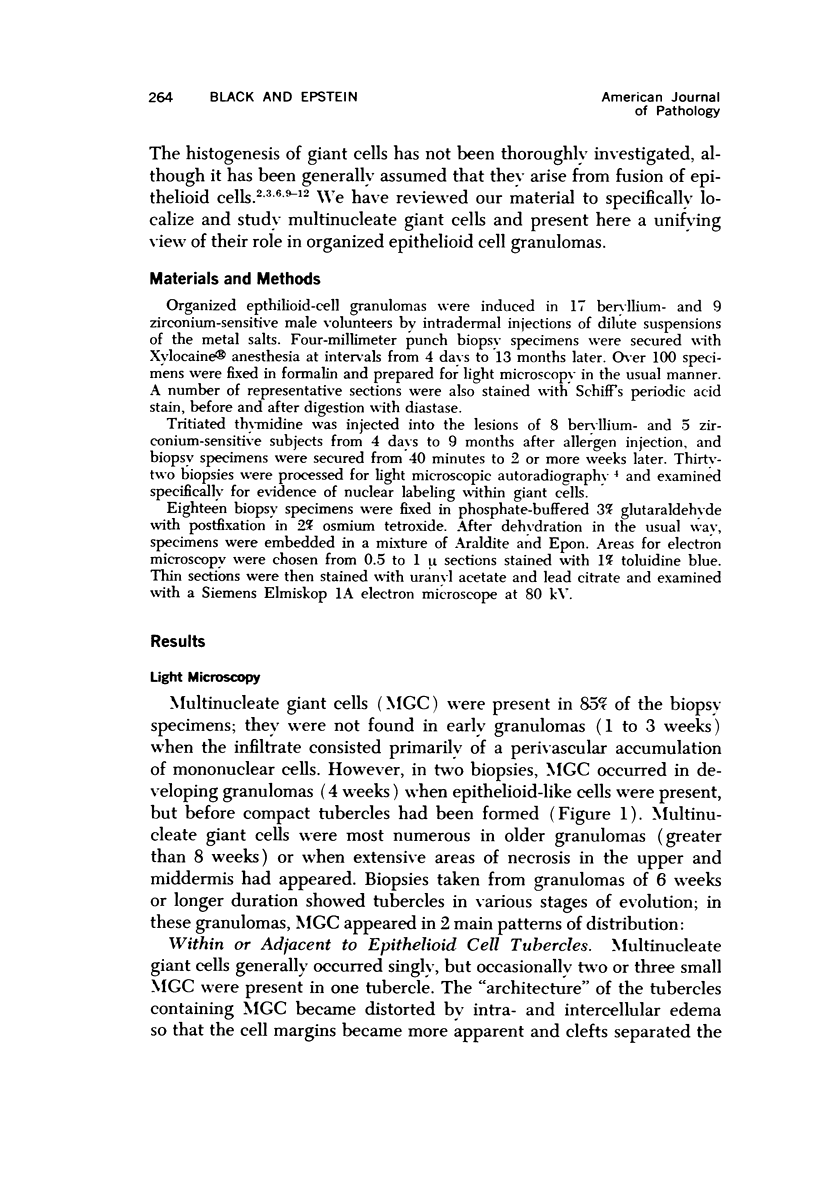Abstract
Organized epithelioid cell granulomas were produced experimentally by injecting intradermally dilute suspensions of zirconium and beryllium salts into individuals who had been previously sensitized to these metals. Biopsies were obtained at intervals of between 5 days and 13 months later, and the specimens were fixed and prepared for light and electron microscopy. Tritiated thymidine was injected into a number of the granulomas; the biopsy specimens were secured from 40 minutes to 2 or more weeks later, and the tissues were processed for light microscopic autoradiography. Giant cells occurred commonly, both within organized tubercles and in relation to areas of necrosis, and had markedly different cytoplasmic features from typical secretory epithelioid cells which enabled them to be readily recognized at scanning magnifications. The characteristic hallmark of these giant cells was the presence of myriads of small mitochondria adjacent to nuclei with numerous membrane-lined vesicles in the center of the cell. Giant cells occurred mainly in edematous disrupted tubercles. In these tubercles, epithelioid cells contained cytoplasmic components more like giant cells. Direct evidence of cell fusion was not seen, although fusion of membranes seemed to occur between cells having similar cytoplasmic features. The failure to find labeled nuclei in any giant cells 40 minutes after injection of tritiated thymidine indicates that normal nuclear division does not occur within giant cells. We postulate that epithelioid cells containing vesicles develop in damaged and necrotic areas, and that mainly this type of epithelioid cell fuses to form giant cells.
Full text
PDF











Images in this article
Selected References
These references are in PubMed. This may not be the complete list of references from this article.
- Azar H. A., Lunardelli C. Collagen nature of asteroid bodies of giant cells in sarcoidosis. Am J Pathol. 1969 Oct;57(1):81–92. [PMC free article] [PubMed] [Google Scholar]
- Carter R. L., Roberts J. D. Macrophages and multinucleate giant cells in nitrosoquinoline-induced granulomata in rats: an autoradiographic study. J Pathol. 1971 Dec;105(4):285–288. doi: 10.1002/path.1711050408. [DOI] [PubMed] [Google Scholar]
- Carter S. B. Effects of cytochalasins on mammalian cells. Nature. 1967 Jan 21;213(5073):261–264. doi: 10.1038/213261a0. [DOI] [PubMed] [Google Scholar]
- Comoglio P. M., Ottino G., Cantino D. Experimental study on development and behaviour of the multinucleated giant cells "in vitro". J Reticuloendothel Soc. 1971 May;9(5):397–408. [PubMed] [Google Scholar]
- DAVIS J. M. THE ULTRASTRUCTURAL CHANGES THAT OCCUR DURING THE TRANSFORMATION OF LUNG MACROPHAGES TO GIANT CELLS AND FIBROBLASTS IN EXPERIMENTAL ASBESTOSIS. Br J Exp Pathol. 1963 Dec;44:568–575. [PMC free article] [PubMed] [Google Scholar]
- Elias P. M., Epstein W. L. Ultrastructural observations on experimentally induced foreign-body and organized epithelioid-cell granulomas in man. Am J Pathol. 1968 Jun;52(6):1207–1223. [PMC free article] [PubMed] [Google Scholar]
- Epstein W. L. Granulomatous hypersensitivity. Prog Allergy. 1967;11:36–88. [PubMed] [Google Scholar]
- Epstein W. L., Krasnobrod H. The origin of epithelioid cells in experimental granulomas of man. Lab Invest. 1968 Feb;18(2):190–195. [PubMed] [Google Scholar]
- Epstein W. L. Methal-induced granulomatous hypersensitivity in man. Adv Biol Skin. 1971;11:313–335. [PubMed] [Google Scholar]
- Gillman T., Wright L. J. Probable in vivo origin of multi-nucleated giant cells from circulating mononuclears. Nature. 1966 Jan 15;209(5020):263–265. doi: 10.1038/209263a0. [DOI] [PubMed] [Google Scholar]
- Hosaka Y., Koshi Y. Electron microscopic study of cell fusion by HVJ virions. Virology. 1968 Mar;34(3):419–434. doi: 10.1016/0042-6822(68)90062-7. [DOI] [PubMed] [Google Scholar]
- Kaminski M. V., Toto P. D. Histogenesis of foreign body giant cells. J Dent Res. 1967 Jan-Feb;46(1):245–247. doi: 10.1177/00220345670460011801. [DOI] [PubMed] [Google Scholar]
- Matthews J. L., Martin J. H., Race G. J., Collins E. J. Giant-cell centrioles. Science. 1967 Mar 17;155(3768):1423–1424. doi: 10.1126/science.155.3768.1423. [DOI] [PubMed] [Google Scholar]
- SILVERMAN L., SHORTER R. G. HISTOGENESIS OF THE MULTINUCLEATED GIANT CELL. Lab Invest. 1963 Oct;12:985–990. [PubMed] [Google Scholar]
- Wanstrup J., Christensen H. E. Sarcoidosis. 1. Ultrastructural investigations on epithelioid cell granulomas. Acta Pathol Microbiol Scand. 1966;66(2):169–185. doi: 10.1111/apm.1966.66.2.169. [DOI] [PubMed] [Google Scholar]
- Williams W. J., James E. M., Erasmus D. A., Davies T. The fine structure of sarcoid and tuberculous granulomas. Postgrad Med J. 1970 Aug;46(538):496–500. doi: 10.1136/pgmj.46.538.496. [DOI] [PMC free article] [PubMed] [Google Scholar]












